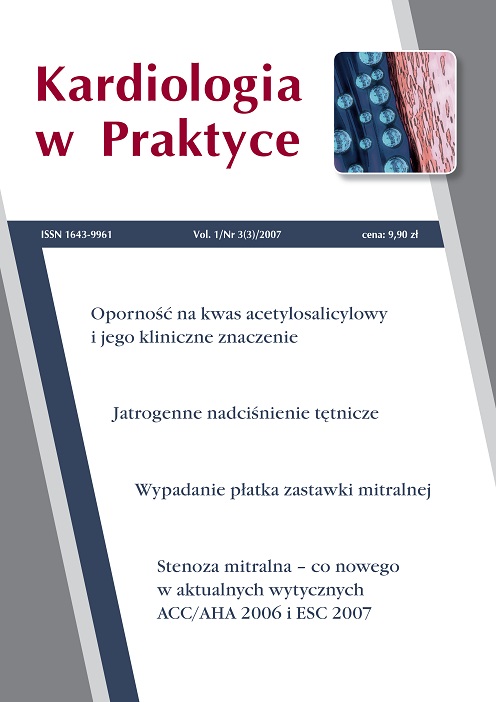Mitral valve prolapse Review article
Main Article Content
Abstract
Mitral valve prolapse (also known as “Barlow’s syndrome”) is the most common heart valve abnormality, affecting 1 to 2,5 percent of the world population. It occurs as a clinical entity with or without thickening and with or without mitral regurgitation. Most people with mitral valve prolapse have no symptoms, however, those who do commonly complain of: palpitations, atypical chest pain, dyspnea, fatigue and neuropsychiatric complaints. The primary diagnostic evaluation of the patient with MVP is the physical examination with the presence of midsystolic click as a principal auscultatory feature and a late systolic murmur of mitral regurgitation. Echocardiography is the most useful diagnostic and prognostic tool. The vast majority of patients with mitral valve prolapse have an excellent prognosis and need no treatment, but the small subset will develop serious complications. Physicians caring for patients with prolapse should identify patients who are at higher risk for complication, attempt to prevent them and optimize the timing for mitral valve surgery, if necessary.
Downloads
Article Details

This work is licensed under a Creative Commons Attribution-NonCommercial-NoDerivatives 4.0 International License.
Copyright: © Medical Education sp. z o.o. This is an Open Access article distributed under the terms of the Attribution-NonCommercial 4.0 International (CC BY-NC 4.0). License (https://creativecommons.org/licenses/by-nc/4.0/), allowing third parties to copy and redistribute the material in any medium or format and to remix, transform, and build upon the material, provided the original work is properly cited and states its license.
Address reprint requests to: Medical Education, Marcin Kuźma (marcin.kuzma@mededu.pl)
References
2. Avierinos J., Gersh B., Dphil. Ch. et al.: Natural history of asymptomatic mitral valve prolapse in the community. Circulation 2002, 106: 1355-61.
3. Caira F., Stock S., Gleason T. et al.: Human degenerative valve disease is associated with up-regularion of low-density lipoprotein receptor-related protein 5 receptor-mediated bone formation. J. Am. Coll. Cardiol. 2006, 47(8): 1707-12.
4. Chetlin M., Alpert J., Armstrong W. et al.: ACC/AHA Guidelines for the clinical application of echocardiography. Circulation 1997, 95: 1686.
5. Jeresaty R.: Mitral valve prolapse. Definition and implication in adults. J. Am. Coll. Cardiol. 1986, 7: 23.
6. Boudoulas H., Wooley C.: Mitral valve. Futura Publishing Company, Armonk, NY 2000.
7. Freed L., Levy D., Levine L. et al.: Prevalence and clinical outcome of mitral valve prolapse. N. Engl. J. Med. 1999, 341: 1.
8. Flack J., Kvasnicka J., Gardin J. et al.: Anthropometric and phisiologic correlates of mitral valve prolapse in a biethnic cohort of young adults. The CARDIA study. Am. Heart J. 1999, 138: 486.
9. Feigenbaum H., Armstrong W., Ryan T.: Wypadanie płatka zastawki mitralnej. W: Echokardiografia. MediPage, Warszawa 2006, 346-351.
10. Firek B., Pasierski T.: Anatomia echokardiograficzna zastawki mitralnej. W: Echokardiografia Praktyczna. Niedomykalność zastawki mitralnej, Szwed H. (red.). WIG-Press, Warszawa 2003.
11. Barlow J., Bosman C.: Aneurysmal protrusion of the posterior leaflet of mitral valve. Auscultatory- electrocardiographic syndrome. Am. Heart J. 1966, 71: 166.
12. Lichodziejewska B., Kłos J., Rezler J. et al.: Clinical symptoms of mitral valve prolapse are related to hypomagnesemia and attenuated by magnesium supplementation. Am. J. Cardiol. 1997, 79: 768-72.
13. Hayek E., Gring Ch., Griffin B.: Mitral valve prolapse. Lancet 2005, 365: 507-518.
14. Guidelines on the management of valvular heart disease. The Task Force on the Management of Valvular Heart Disease of the European Society of Cardiology. European Heart Journal 2007, 28: 230-268.

